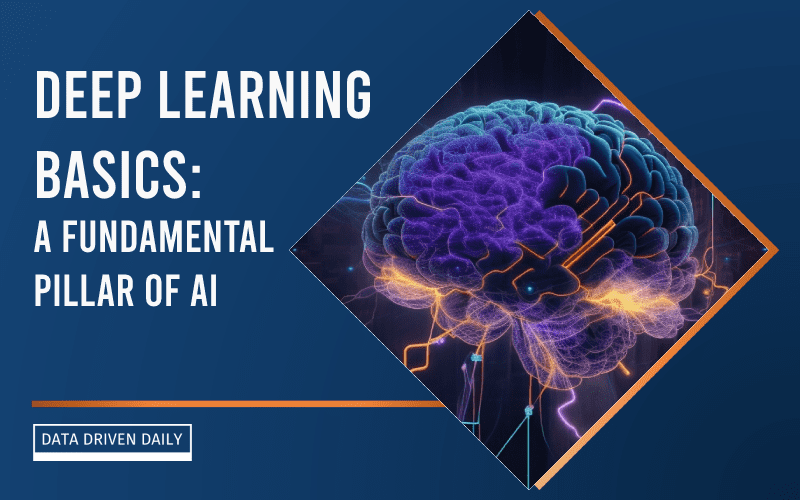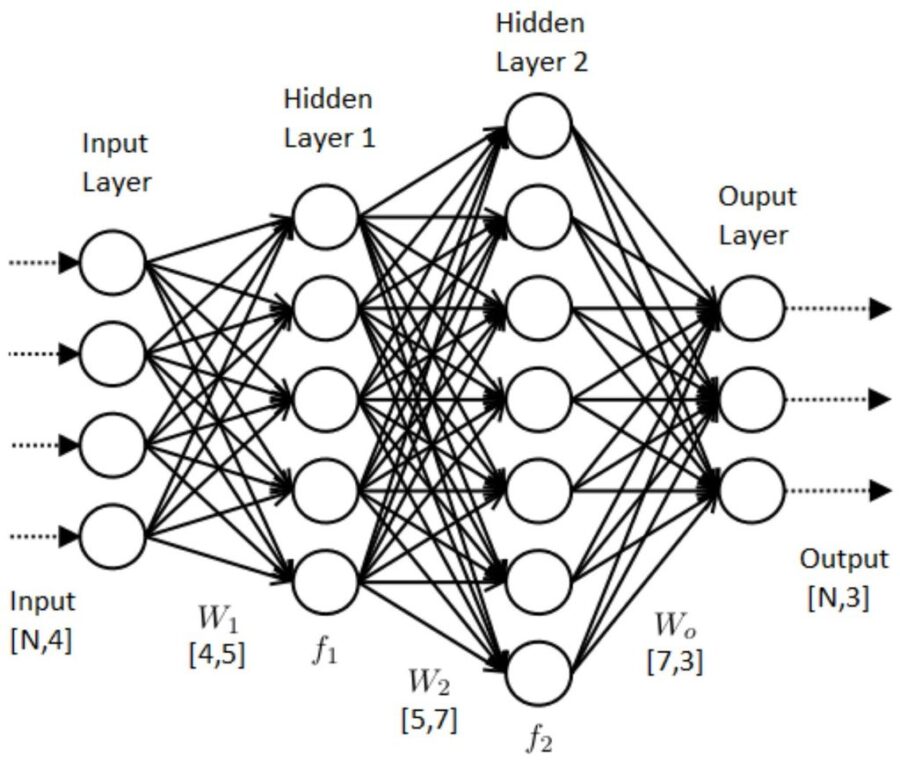To understand the transformative power of artificial intelligence (AI), we need to dive into one of its most essential subfields – deep learning.
As we traverse this complex yet fascinating terrain, we’ll unravel the deep learning basics and shed light on how AI deep learning is shaping our world.

The Genesis of Deep Learning
But first, let’s step back a little. The history of deep learning parallels the evolution of the human brain itself. Intrigued? Let me explain. Deep learning models, at their core, are inspired by the neural networks in our brains. Just as neurons learn to recognize patterns through repeated exposure and reinforcement, deep learning algorithms follow a similar pathway, hence their label, artificial neural networks.
It all started back in the 1940s when Warren McCulloch and Walter Pitts first introduced a mathematical model of a biological neuron. This laid the groundwork for what would eventually become deep learning. However, it was not until the advent of more powerful computing systems and the availability of large datasets that deep learning truly started to take off.
Deep Learning: The Essential Mechanics
To fully appreciate the realm of deep learning, it’s crucial to grasp its underlying mechanics. Let’s break down the deep learning basics into digestible bites, just as you would approach a complex problem and distill it into simpler parts.
Deep learning, as its name implies, is a branch of machine learning where artificial neural networks – inspired by our brains – delve deep into data sets to unearth patterns and correlations. Sounds pretty abstract, doesn’t it? Let’s try to make it more concrete.
Artificial Neural Networks: The Foundation

Artificial neural networks (ANNs), the backbone of deep learning, are computing systems vaguely inspired by the biological neural networks constituting animal brains. An ANN is built up of a large number of interconnected processing elements, working in unison to solve specific problems.
Imagine a colossal web, with numerous nodes, each acting as a tiny, abstract version of a neuron in the human brain. These artificial ‘neurons’ process the information they receive and pass it on, creating a dynamic system of learning and adaptation.
Layers, Layers, and More Layers
Neural networks are structured in layers, giving rise to the term ‘deep’ in deep learning. You can visualize this as a multi-layered cake, with each layer playing its distinct role.
The layers can be broadly categorized into three types:
- Input Layer: This is the layer that receives input from our dataset. For instance, if the network is meant to identify objects within an image, the input would be the pixels of the image.
- Hidden Layers: These are the layers between the input and output layers, where the real computation happens. Each hidden layer extracts features from the input data. The ‘depth’ of deep learning refers to the number of these hidden layers in the network.
- Output Layer: As the name suggests, this is the final layer that outputs a decision or prediction based on the learned patterns and correlations.
Learning from the Data: The Crux of Deep Learning
One of the remarkable aspects of deep learning is its ability to automatically learn features from the data. As data passes through each layer of the network, the model learns and identifies increasingly complex features.
For instance, when processing images, the initial layers might identify edges and colors. The middle layers might recognize more complex shapes or features like an eye or a wheel, and the final layers could potentially recognize entire objects like a human face or a car.
This automatic feature extraction is a significant departure from traditional machine learning, where a data scientist would need to manually identify and program these features.
Through this layered, progressive approach, deep learning models can learn, adapt, and evolve – echoing the dynamic, ever-evolving state of our own brains. This power to learn from vast amounts of data and improve over time is what makes deep learning such a formidable force in AI, influencing countless applications and industries.
Delving Deeper: Practical Aspects of Deep Learning
As we venture further into the mechanics of deep learning, we discover an exciting world of tools, methodologies, and best practices. Whether you’re a seasoned professional or a curious enthusiast eager to dip your toes in the AI pool, this section should provide valuable insights.
Tools of the Trade: Libraries and Frameworks
Harnessing the power of deep learning involves leveraging a suite of sophisticated tools designed to simplify and streamline the process.
- TensorFlow: Developed by the Google Brain team, TensorFlow is arguably the most popular library for deep learning. It provides a comprehensive ecosystem of tools, libraries, and resources that allows researchers and developers to build and deploy machine learning models.
- PyTorch: A brainchild of Facebook’s AI Research lab, PyTorch is beloved by the AI research community for its simplicity and ease of use. It also provides excellent support for GPU acceleration, which is vital for training large deep learning models.
- Keras: If you’re just starting your deep learning journey, Keras might be the perfect tool for you. It’s a high-level neural networks API, capable of running on top of TensorFlow, and designed to enable fast experimentation with deep neural networks.
Methodologies: Supervised, Unsupervised, and Reinforcement Learning
Deep learning models can learn from data in several ways:
- Supervised Learning: In this methodology, the model is trained on a labeled dataset. That is, each example in the training data includes both the input and the correct output. The model learns to map the inputs to the outputs, akin to a student learning from a teacher.
- Unsupervised Learning: Here, the model is given a dataset without any labels or categories. The aim is for the model to find patterns and structure in the data on its own. This approach is like learning to navigate a new city without a map.
- Reinforcement Learning: This methodology is all about learning from interaction with an environment. An agent takes actions, which result in rewards or penalties. The agent learns to make better decisions by striving to maximize the total reward. This is similar to a child learning to ride a bicycle.
Approaches: From Feedforward to Convolutional Neural Networks
Different problems require different types of deep learning models:
- Feedforward Neural Networks (FNNs): These are the simplest type of artificial neural network. Information in an FNN only travels in one direction—from the input layer, through the hidden layers, to the output layer.
- Convolutional Neural Networks (CNNs): CNNs excel at processing grid-like data such as images. They use a specialized layer (the convolutional layer) to process small portions of the input data at a time, allowing the model to recognize local patterns.
- Recurrent Neural Networks (RNNs): RNNs are designed to work with sequential data. They have loops that allow information to be passed from one step in the sequence to the next. This feature makes RNNs particularly useful for tasks like language modeling and speech recognition.
How to Get Started with Deep Learning
Starting with deep learning might seem like a daunting task, given its complexity and the breadth of the field. However, a structured approach can make the journey manageable and rewarding. Start by solidifying your understanding of linear algebra, calculus, probability, and programming. Then, move on to machine learning basics and gradually delve into deep learning. Engage with online courses, tutorials, and hands-on projects. Experimentation is key, so keep tinkering, building models, and most importantly, having fun!
Remember, deep learning, like any other field, requires patience, perseverance, and relentless curiosity. The journey might be challenging, but the rewards are certainly worth it. Keep learning, keep evolving, and remember—the best way to predict the future is to create it.
AI Deep Learning Applications Transforming Industries
Healthcare: Early Diagnosis and Personalized Medicine
In the realm of healthcare, AI deep learning is proving to be a game-changer. From diagnosing diseases at early stages to predicting patient risk factors, it’s revolutionizing patient care.
AI algorithms can analyze medical images (like X-rays or MRIs) with precision comparable to trained professionals. For instance, Google’s DeepMind developed an AI that could diagnose 50 different types of eye disease as accurately as expert doctors.
Personalized medicine is another area where deep learning shines. By analyzing a patient’s genetic makeup, AI systems can predict their susceptibility to specific diseases and suggest personalized treatments – truly transforming healthcare from reactive to proactive.
E-commerce: Personalized Customer Experience
If you’ve ever shopped online, you’ve likely experienced AI deep learning in action. E-commerce giants like Amazon use deep learning algorithms to analyze your past purchases, browsing history, and ratings to provide personalized product recommendations.
These AI systems can predict future buying behavior, helping retailers manage inventory more effectively. The result? A win-win situation for both retailers and customers.
Autonomous Vehicles: Navigating the Roads with AI
The dream of self-driving cars is closer than ever, thanks to deep learning. These AI systems can analyze massive amounts of data from various sensors and cameras, helping the vehicle recognize traffic signs, pedestrians, and other obstacles.
In fact, Tesla’s Autopilot, one of the most advanced self-driving systems on the road today, leverages deep learning to continually improve its understanding of real-world conditions.
The Challenges and Future of AI Deep Learning
Despite its incredible potential, AI deep learning is not without its challenges. The need for large datasets and substantial computing power, the lack of interpretability (often termed the ‘black box’ problem), and susceptibility to bias are key areas of concern.
However, the relentless march of technology is continually mitigating these challenges. The development of more efficient algorithms, combined with advances in hardware technology, is making deep learning more accessible than ever.
Looking to the future, the possibilities seem boundless. We are inching closer to the day when AI systems will converse like humans, robots will learn tasks by merely observing, and personalized education will be a reality for all. And deep learning will be at the heart of it all.
The importance of deep learning in the realm of AI cannot be overstated. As we continue to unravel its full potential, we are not just redefining the boundaries of technology but reshaping humanity’s future.
Ben is a full-time data leadership professional and a part-time blogger.
When he’s not writing articles for Data Driven Daily, Ben is a Head of Data Strategy at a large financial institution.
He has over 14 years’ experience in Banking and Financial Services, during which he has led large data engineering and business intelligence teams, managed cloud migration programs, and spearheaded regulatory change initiatives.